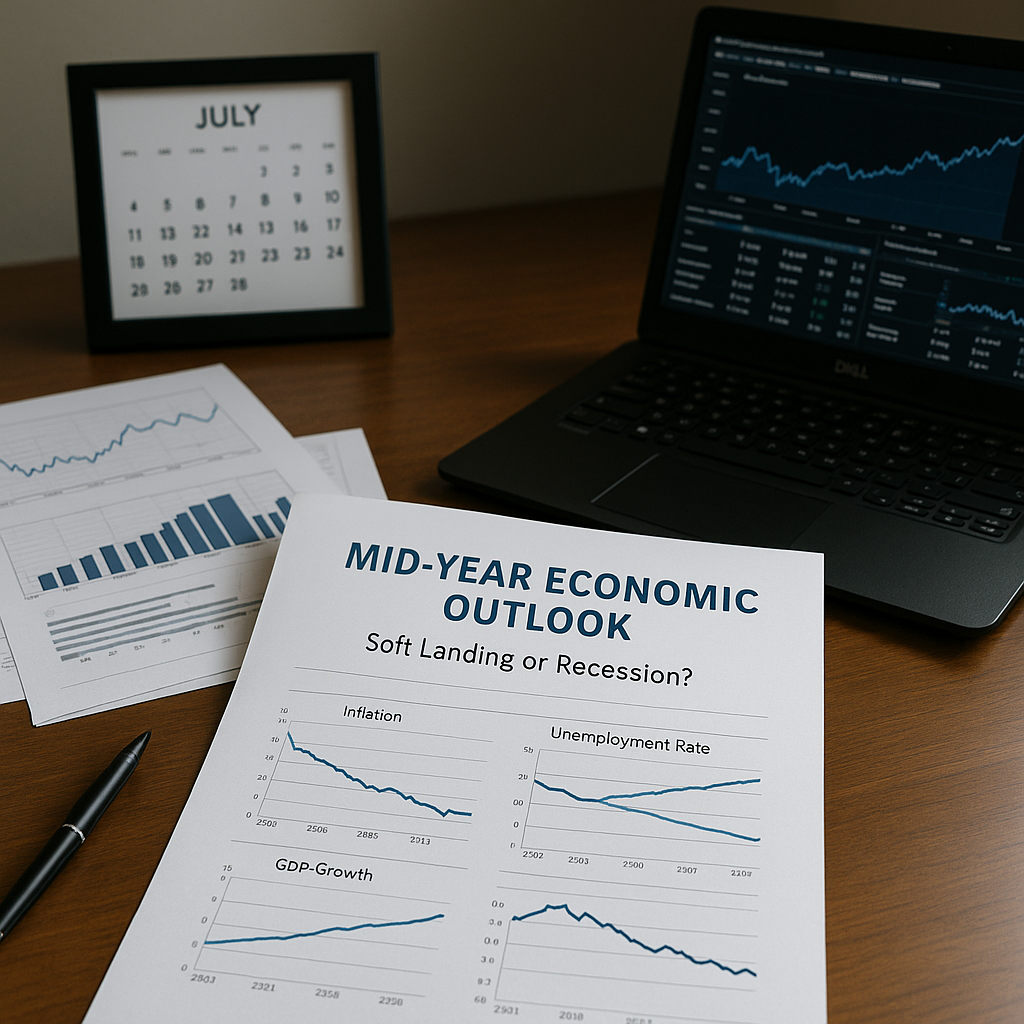Mid-Year Outlook: Soft Landing or Recession?
As we reach the halfway point of 2024, global markets are assessing one key question: Can the U.S. and other major economies achieve a soft landing, or is a recession still looming?
After two years of aggressive monetary tightening, inflation appears to be cooling, labor markets remain resilient, and consumer spending is holding — but cracks are beginning to show. With the Federal Reserve pausing rate hikes, and the European Central Bank cautiously optimistic, investors are recalibrating their portfolios amid a backdrop of uncertainty and fragility.
What Is a Soft Landing?
A soft landing is an economic scenario in which central banks successfully tame inflation without triggering a recession. It typically involves:
-
Slowing GDP growth
-
Stabilizing inflation near targets (around 2%)
-
Moderate unemployment increases
-
Avoidance of widespread economic contraction
It is the ideal outcome after a tightening cycle — but achieving it is notoriously difficult.
The Case for a Soft Landing
1. Inflation Is Easing
-
U.S. CPI (June 2024) came in at 2.6% YoY, down from 6.4% just 18 months ago.
-
Core PCE, the Fed’s preferred measure, has now hovered below 3% for three consecutive months.
-
Energy and food prices have stabilized, while supply chain pressures have largely normalized.
This gives policymakers more flexibility and reduces the need for further rate hikes.
2. Labor Markets Are Resilient
-
U.S. unemployment remains at a low 4.1%.
-
Job creation, though slower, continues in health care, energy, and AI-related industries.
-
Wage growth has cooled to a sustainable 3.5%, easing inflationary pressure without collapsing demand.
3. Markets Are Calm (For Now)
-
Equity indices like the S&P 500 and Euro Stoxx 50 are up ~8% YTD.
-
Credit spreads remain tight, indicating low stress in corporate debt markets.
-
Volatility indices are subdued, reflecting investor confidence in the short term.
Altogether, these signals point toward a controlled deceleration, the hallmark of a soft landing.
But Risks Remain: Why a Recession Is Still Possible
Despite optimism, several underlying factors suggest recession risks are not off the table.
1. Consumer Fatigue
-
Credit card delinquencies are rising, especially among lower-income households.
-
Savings rates are below pre-pandemic levels, and real disposable income is flat.
-
Retail sales have softened since Q2 began, pointing to consumer exhaustion after a strong 2023.
2. Corporate Margins Are Tightening
-
Earnings growth is slowing, particularly in retail, real estate, and manufacturing.
-
Input costs remain elevated, and pricing power is weakening.
-
Investment activity is subdued, especially among small- and mid-cap firms.
These conditions often precede layoffs and capital spending cuts.
3. Lagging Effects of Monetary Policy
-
The full impact of 2022–2023 rate hikes is still working through the system.
-
Commercial real estate stress is growing, especially in urban office markets.
-
Regional banks remain under pressure, with higher default risks and tighter lending standards.
History shows recessions often arrive 12–24 months after the final rate hike.
Global Economic Signals
Europe
-
Eurozone growth is tepid, with Germany flirting with technical recession.
-
Inflation is at 2.9%, but labor market softness persists.
-
ECB remains cautious, signaling no rate cuts until Q4.
China
-
Post-COVID recovery has lost momentum.
-
Real estate sector remains fragile, and exports are weak.
-
Stimulus efforts are underway but may not be enough to boost global demand.
Emerging Markets
-
Resilient commodity prices have helped Latin America.
-
India continues to post strong growth, while Turkey and South Africa face inflation struggles.
-
Debt servicing in Africa remains a concern amid a strong U.S. dollar.
What the Fed Is Saying
At its June 2024 meeting, the Federal Reserve:
-
Kept rates at 5.25%–5.50%
-
Indicated no further hikes planned for 2024
-
Suggested one or two rate cuts may occur in Q4, depending on data
Chair Jerome Powell stated:
“We are encouraged by inflation progress but remain data-dependent. A soft landing is possible, but vigilance is still required.”
Market Scenarios for H2 2024
| Scenario | Description | Probability |
|---|---|---|
| Soft Landing | Inflation eases, growth slows, no recession | 50% |
| Mild Recession | Consumer demand drops, unemployment rises | 30% |
| Stagflation | Growth stalls but inflation persists | 10% |
| Re-acceleration | Lower rates reignite demand and investment | 10% |
Most strategists now lean toward a soft landing base case, but the margins are narrow.
How Investors Are Positioning
Equities
-
Rotation into value stocks and defensive sectors (utilities, health care)
-
AI and tech remain strong, but with more selective allocations
-
Dividend-paying stocks gain favor for stability
Fixed Income
-
Investors are adding duration, anticipating eventual rate cuts
-
High-grade corporate bonds and munis are in demand
-
Riskier credit is being trimmed in cautious portfolios
Alternatives
-
Gold remains above $2,100/oz, supported by central bank demand
-
Bitcoin has consolidated near $70,000 after ETF inflows
-
Private credit and infrastructure are attracting institutional flows
What to Watch in the Coming Months
-
Q2 GDP Reports: Any contraction will spark immediate recession concerns
-
Labor Market Trends: Rising unemployment or wage stagnation would confirm slowing momentum
-
Inflation Prints: A return above 3% would derail soft landing hopes
-
Corporate Earnings (Q3 Season): Will firms beat lowered expectations or guide down?
-
Fed Signals in Jackson Hole (August): Could hint at timeline for rate cuts
Conclusion: Balance, Not Certainty
As of July 2024, the global economy walks a tightrope. The Fed has paused. Inflation is falling. Growth is slowing — but not collapsing. In this moment of transition, markets are betting on a soft landing, but the landing zone is narrow.
For investors and policymakers, flexibility is key. Whether we achieve a soft landing or slip into recession will depend on consumer behavior, corporate resilience, and policy response.
